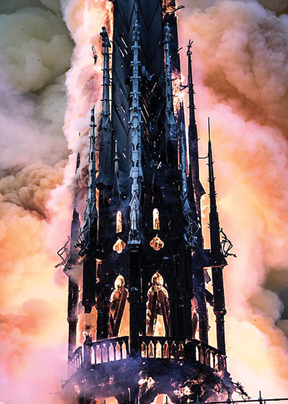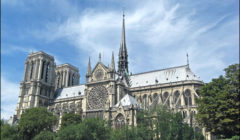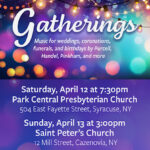Thinking about Notre Dame
I first learned that Notre Dame Cathedral was burning when my Android device notified me that a European Facebook page devoted to preserving natural mother/child bonds had posted video of the fire, which had been burning for just over an hour.  I quickly phoned my mother to tell her. News and concern spreads quickly in our electronic age and in the days following the fire, wealthy French citizens pledged nearly $700 million toward rebuilding Notre Dame which is owned by France and the French. And, I hear that “we” should feel angry about this.
I quickly phoned my mother to tell her. News and concern spreads quickly in our electronic age and in the days following the fire, wealthy French citizens pledged nearly $700 million toward rebuilding Notre Dame which is owned by France and the French. And, I hear that “we” should feel angry about this.
According to Merriam-Webster, all churches, synagogues, and Temples —Jewish, Buddhist, Hindu, Masonic, Labor and otherwise— are temples, as are “the flattened spaces on each side of the forehead” between which our brains sit as we wonder and reason why things happen as they happen. Temples like Notre Dame are called cathedrals because they house the seat, (cathedra,) of a bishop who guides subordinates in their guidance of those who flock to that cathedral for community and purpose. Notre Dame, named for Our Lady, the Blessed Mother, looms large in western history.
Notre Dame Cathedral is said to contain 52 acres of timber; its attic was known as “the forest.” According to Fortune Magazine, workers began in 1160 to harvest the primary growth virgin forest from which “the forest” and other parts of Notre Dame were constructed. Actual construction started in 1163 and the cathedral was completed under King Louis VII in 1345, a date which falls within the Avignon Papacy, a brief period from 1309 to 1376 during which seven popes resided not in Rome but France. Fortune Magazine suggests that during Notre Dame’s construction, wood was already becoming scarce as towns and farms cleared the land, and today, only 4% of Europe’s original forests remain.
Civilization brings baggage and some of that baggage affected Notre Dame. Following the Protestant Reformation French Huguenots smashed statues they believed to be idolatrous. Catholic statuary and Catholic veneration of Our Lady still sparks arguments. In Showtime’s series, SMILF, an acronym which changes meaning each episode, Boston mother Bridgette Bird experiences an epiphany while looking at a statue of the Virgin Mary. Bridgette expresses how she would like to have read Mary’s diary lamenting that someone else got to keep Mary’s diary. Bridgette “rescues” the statue. 
During the French Revolution, Notre Dame was recommissioned as the “Temple of Reason.” Revolutionaries decapitated statues of the 28 Kings of Judah thinking the statues honored French monarchs. The “Cult of Reason” replaced some statues of Our Lady with statues of the Goddess of Reason. Historical sources suggest The Goddess of Reason was modeled after the Greek Goddess Athena, interestingly, herself a virgin. Athena’s mother, the Titan Metis, like her daughter Athena, is associated with wisdom and skill. But in notoriety, Athena eclipses Metis perhaps because myth claims that Athena was born, fully formed, from her father Zeus’s head. The ancient Greeks, who believed they communicated directly with their gods and goddesses, also believed that sperm contained fully formed mini-humans or homunculi.
Greece’s Parthenon is a temple dedicated to the Athena.
East of Paris and Greece, the Hagia Sophia, a temple to Holy Wisdom, was built in 537 as the cathedra of the Eastern Orthodox Patriarch of Constantinople. For a few decades of her history, Crusaders changed Hagia Sophia into a Roman Catholic Cathedral, but the church eventually returned to Byzantine control. In 1453, when the Ottoman Turks took over Constantinople, renaming the city Istanbul, Hagia Sophia was turned into a mosque. In 1935, the Turkish government secularized the building, opening Hagia Sophia as a museum.

Notre Dame’s stint as the Temple of Reason did not last long. The structure itself fell into disrepair and was briefly repurposed as a food warehouse. Later, when the revolutionary Jacobins fell from grace, Napoleon Bonaparte and the people of France, while maintaining ownership of Notre Dame, restored use of the cathedral, at no cost, to the Catholic Church. Inside Notre Dame, in 1804, Pope Pius VII handed Napoleon the crown with which Napoleon crowned himself, an act which may have served to underscore Napoleon’s thinking about Church’s place in Napoleon’s realm. Diverging thoughts about religion’s power within larger diverse realms fuels much conflict today.
May, still, for many Catholics, is the month of Mary, the mother of Jesus – the Blessed Mother, Notre Dame. May Day is an international labor holiday, a celebration of Spring and America’s phonetic spelling of the French call for help, “m’aidez.”
Many in France and elsewhere need help.
The Christian humanist, Erasmus, said, “the entire world is my temple…”
Worlds exist between our temples.











